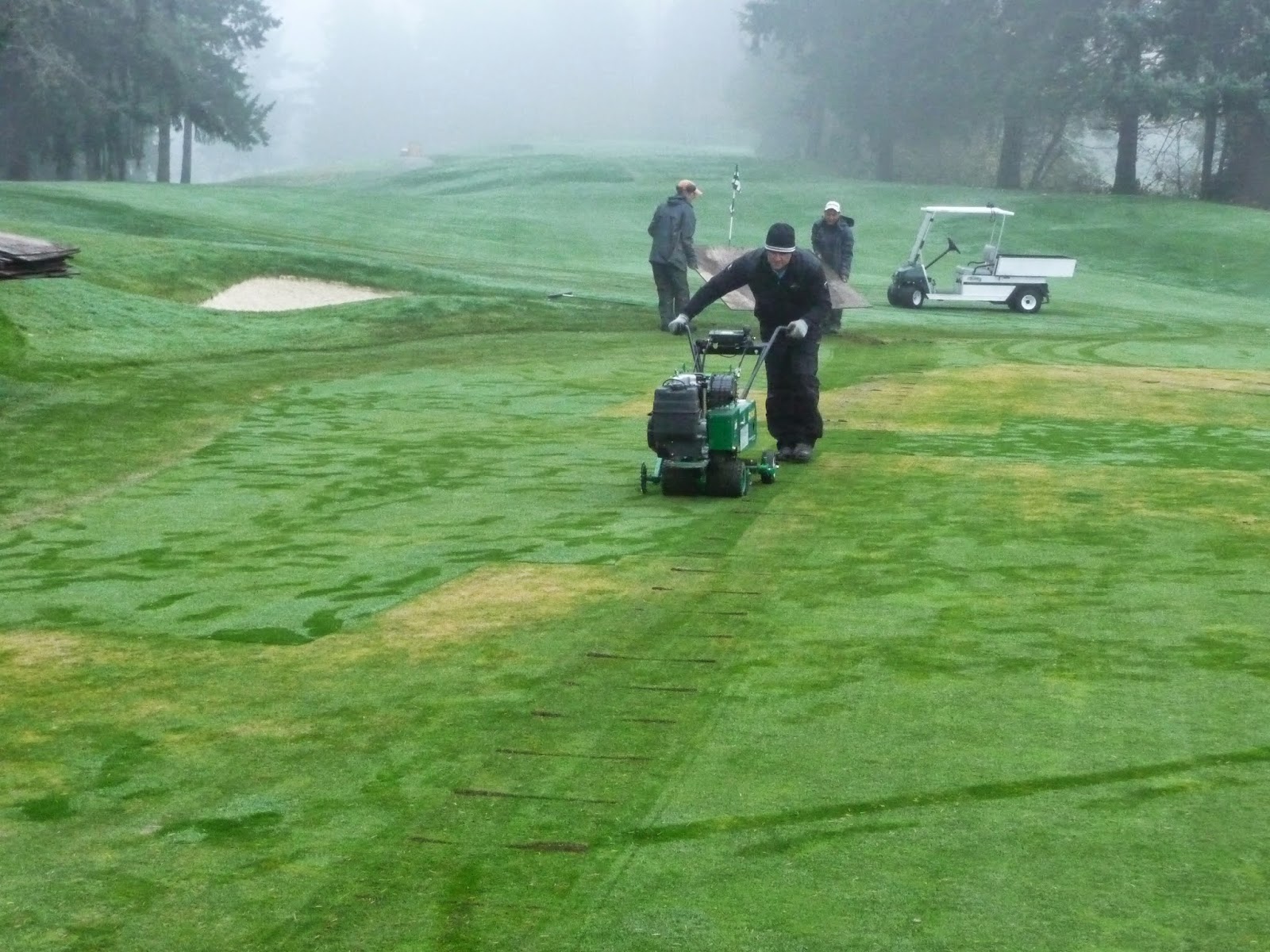Monday April 14th was the day we aerated greens for spring 2014. The weather was 70 degrees and sunny which is perfect conditions for aerating greens. The process was different than in all the years past, we used solid tines compared to hollow cores tines. Hollow core tines are the ones used to remove a core, solid tines punch a hole into the ground. The reason we aerate greens is to relieve soil compaction, get air to the plant roots, and create a space for sand to be placed in the root zone. Getting sand into the root zone is critical to dilute the amount of organic matter that accumulates in the soil. Organic matter comes from dead roots and shoots, and is increased by the amount of fertilizer and water used. A green that has excess organic matter is soft and spongy, doesn't drain well, shows visible foot prints from golfer foot traffic, and is not a good putting surface. Research at the University of Nebraska over the past 15 years has shown that the key to controlling organic matter build up in the soil is getting sand into the root zone. The method of sand placement can be done by several methods; deep verticutting , hollow tine core aeration, and solid tine aeration. As long as the amount of sand used is the same over the span of a year, all three methods work and dilute the organic content the same. We verticutt and lightly sand our greens every other week from May to September, and aerate with heavier sanding in April and September. In previous years we have always pulled a core when aerating greens, then filled the holes with sand. It's a difficult process to get the cores picked up without damaging the greens surface and getting sand to fill the holes. If the sand isn't dry enough it will bridge across the tops of the holes and not fill them. Driving equipment across the soft freshly aerated surface causes ruts in the green which take a lot of rolling to smooth out. Spacing between the holes is critical also. If they are too close together, the machine will almost roto-till the surface. The tightest spacing with hollow cores we were able to use was 2" X 2". With solid tines we used a 1.5" X 2" spacing because there is less surface disruption compared to hollow core tines. We topdressed the green first and allowed the sand to dry, then aerated with solid tines and drove the sand into the holes. We then did a quick drag across the green to fill the holes all the way with sand. With solid tines we punched more holes and used more sand, caused minimal surface disruption, and cut the recovery time in half as compared to hollow core aeration. The greens are firmer from additional sand and will also drain better. I took samples from all the greens prior to aeration and sent them to a soils lab to have the organic content checked. I'll take samples next year at the same time to compare the levels of organic matter and the numbers should be lower. Photos of the entire process below show how the job was done.


The first step is to spread a heavy layer of sand on the green and wait about four hours until it's dry.

The two photos above show the difference between a solid tine (no core pulled) and a hollow core tine (pulls a core).
The green is then aerated with solid tines. Vibration from the machine helps drop more sand into the holes and windrow attachments mounted on the back of the aerator drag sand into holes not yet filled.
The 10 second video above shows the aerator at work.
The next step is to drag the green with a brush unit to even out the layer of sand.
After the first drag, a verticutter is used to cut 1/4" deep grooves in the green to make additional space for sand on the green surface. It also fills in any remaining holes that are not filled. After verticutting we do one more quick drag and are ready to water the green for 20 minutes. Once all the greens have been watered, we are done with day one of the process.
Day two of greens aeration starts with removal of excess sand. We use another brush unit that moves the sand to one end of the green where it can be picked up and hauled off.
We're getting close completion. Here you see Joel, Mario, and Nate blowing off excess sand on the 14th green.
The greens are then rolled two directions to smooth out the surface and we're done! All the holes are filled and this is what it looked like at the end of day two. The greens are ready for play and the recovery time to get back to normal is reduced by at least one week.




























